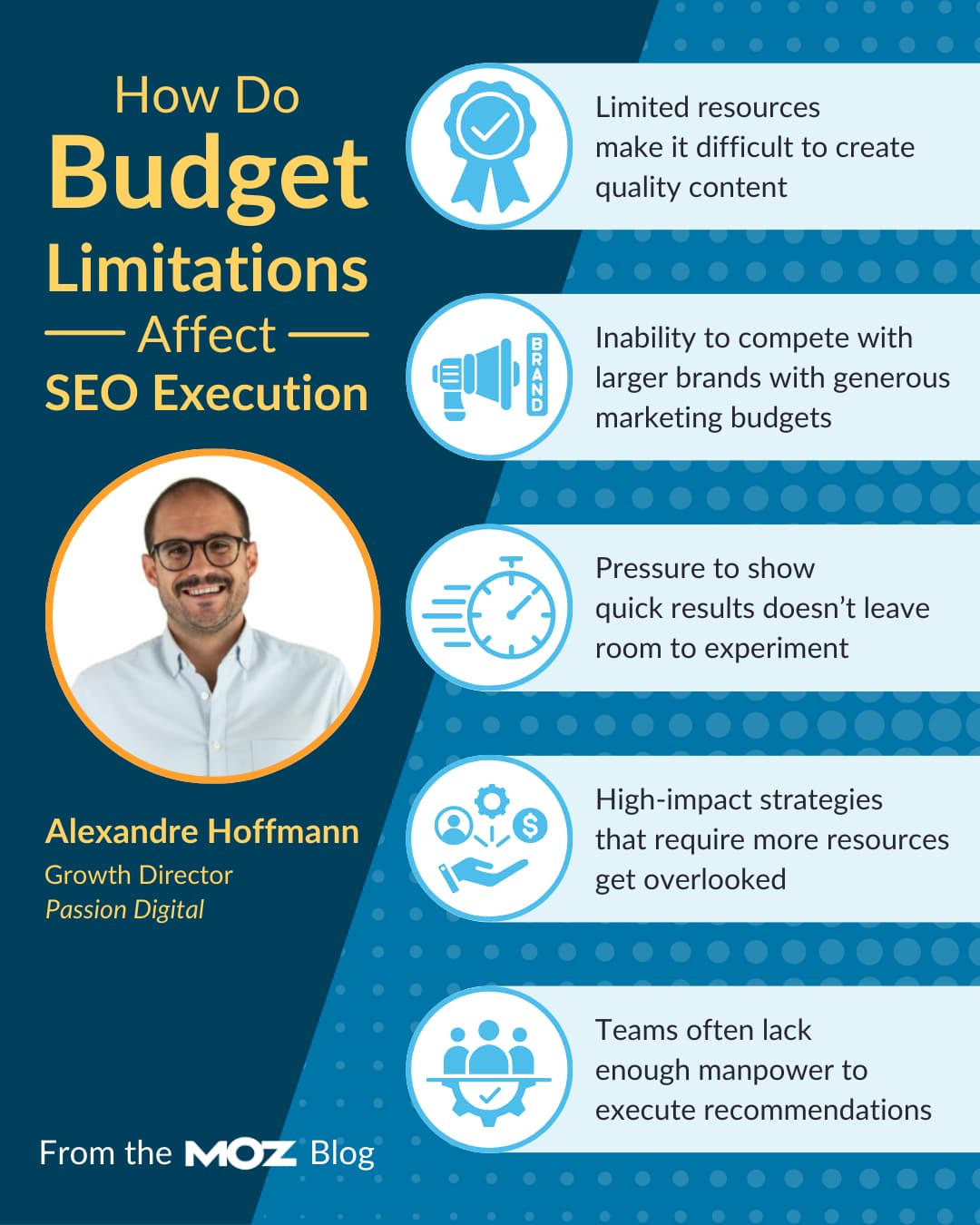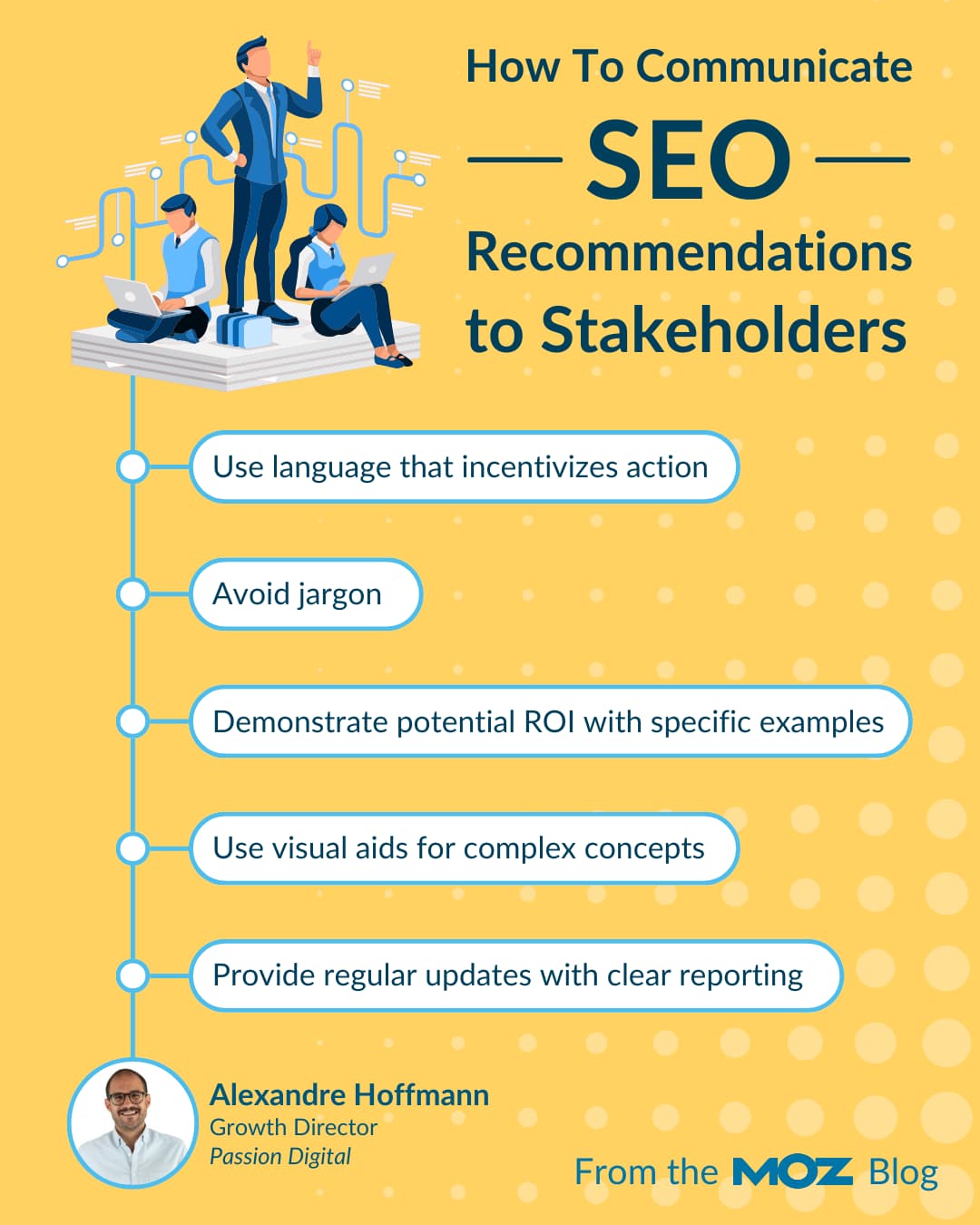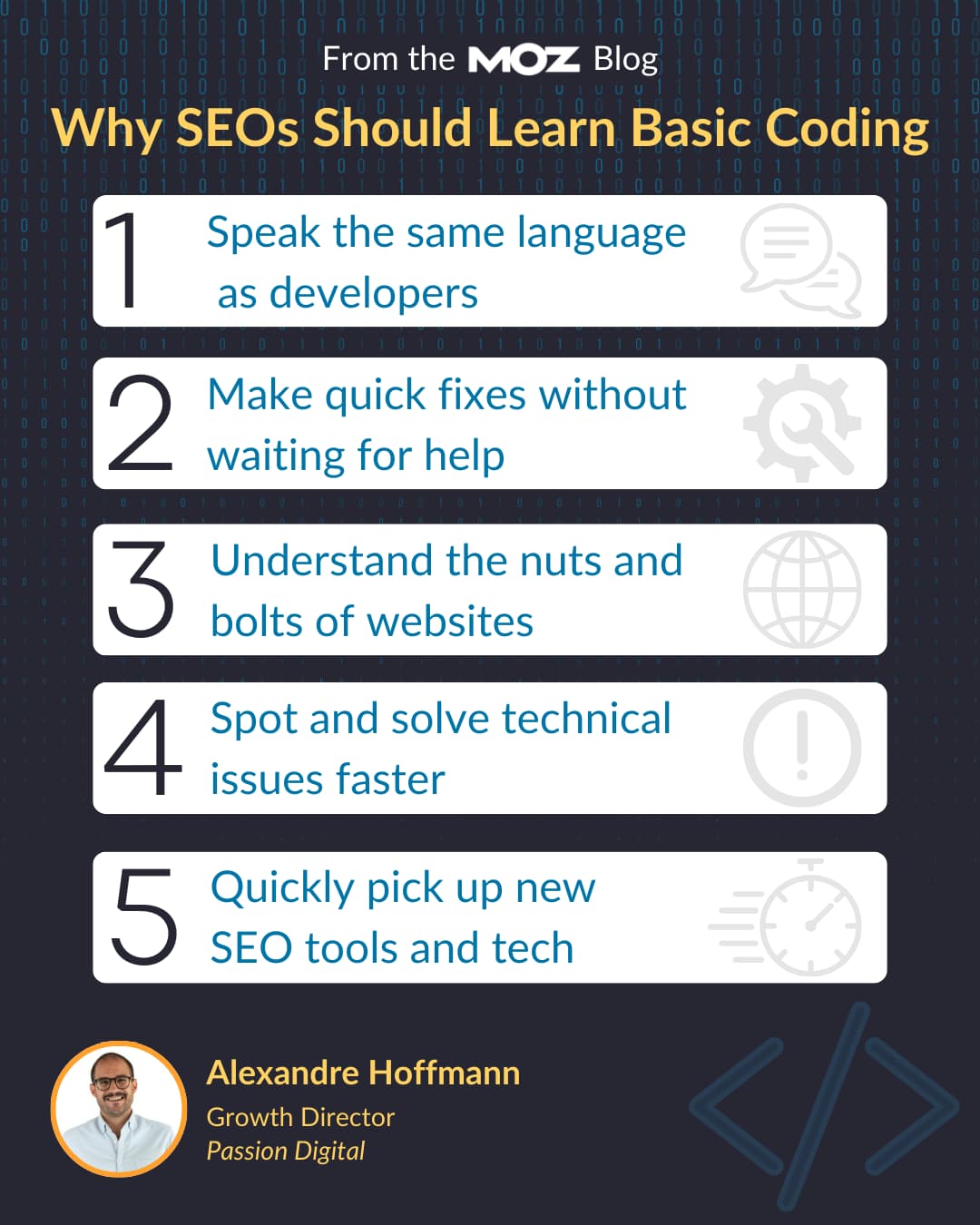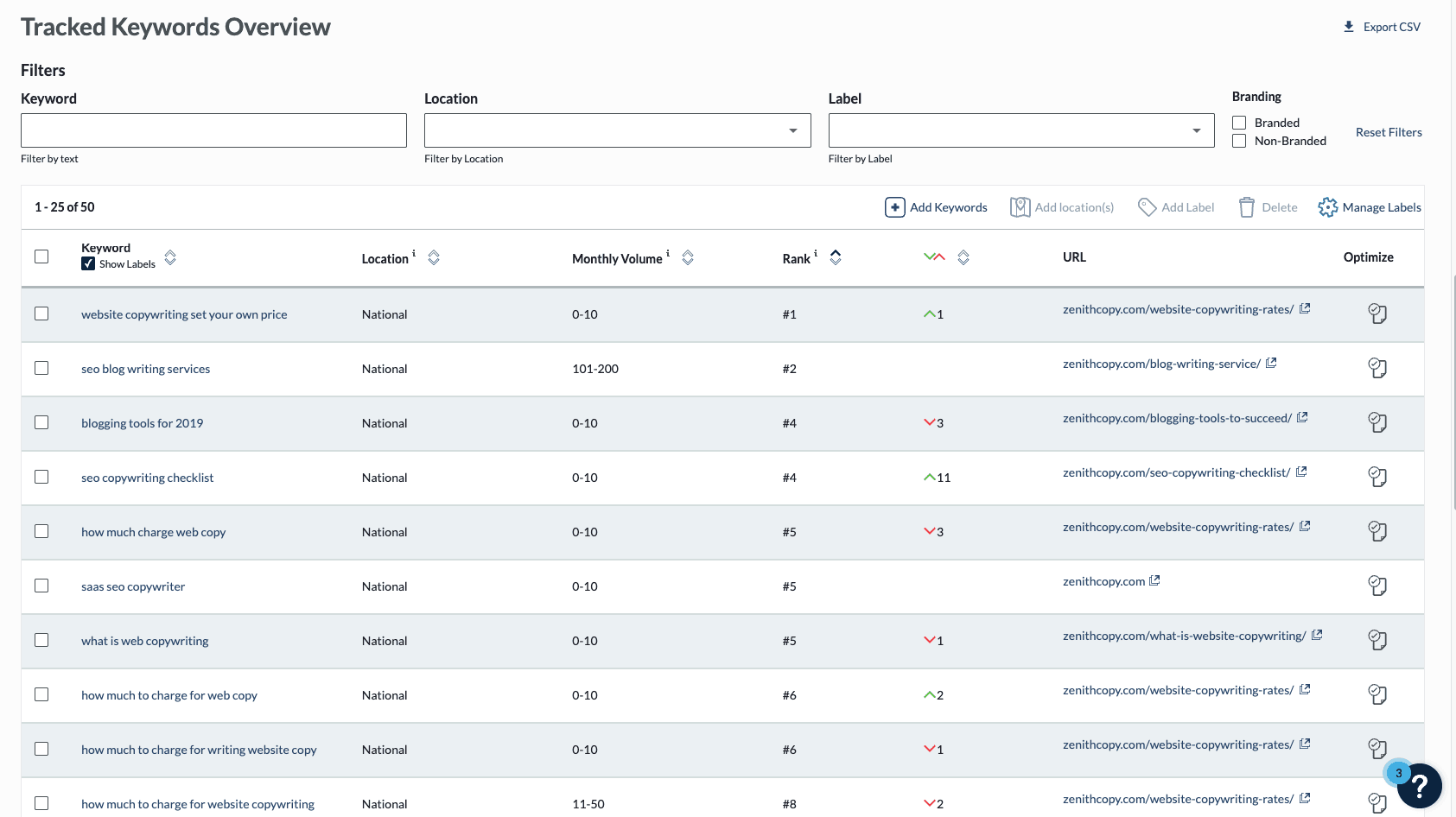
How to Close the Gap Between SEO Recommendation and Execution
The author's views are entirely their own (excluding the unlikely event of hypnosis) and may not always reflect the views of Moz.
Picture this scenario.
You've just created the perfect SEO strategy — impeccable keyword research, solid technical recommendations, and a comprehensive content plan that’s chef’s kiss. It’s brilliant work, and it should deliver results.
Yet, three months later, rankings haven’t budged, and you're wondering why that brilliant strategy didn't translate into results.
As an SEO consultant who has worked with hundreds of businesses, I've seen this pattern repeatedly. The gap between SEO recommendations and execution is the silent killer of otherwise successful campaigns.
In this article, I’ll give you a blueprint for presenting SEO recommendations in a way that removes friction and ensures clients execute them properly.
But first, let’s talk about why SEO strategies fail
Budget limitations
Budget constraints are perhaps the biggest obstacle to execution. Here are a few ways budget limitations affect SEO execution:

Content quality: Limited resources make it harder to create quality content. For example, clients might not have the funds to purchase content tools or hire a graphic designer to create digital assets that improve readability.
Ability to compete: Scaling quickly and building topical authority becomes difficult when resources are stretched thin. This makes it difficult to compete with larger brands with a higher marketing budget.
Experimentation: Pressure to show quick results doesn’t leave room to test new strategies. Instead, short-term tactics take priority over long-term growth, an approach that isn’t sustainable.
Resource allocation: High-impact strategies that require more resources get overlooked in favor of those that demand less but deliver smaller gains.
Hiring talent: Teams often lack enough technical SEO and content specialists, leading to an imbalance where content fixes might be implemented and technical SEO ignored.
Poor communication between teams
When teams aren’t aligned, SEO falls apart. Different departments chase their goals, leading to fragmented strategies and ineffective execution. SEO is a team sport that requires collaboration; otherwise, rankings suffer.
How to bridge the execution gap
We’ve discussed some common reasons SEO strategies fail, but now, let’s take a more positive slant.
I’ll now explain what you can do to bridge the gap between SEO recommendation and execution. I’ll also share actionable strategies to keep your campaigns on track and squeeze every last drop of value from your efforts.

Communicate effectively
Execution depends on getting buy-in from stakeholders and other teams, which requires communicating in a way that resonates with their priorities.
Use language that incentivizes action
For developers:
When communicating with developers, focus on the impact of SEO changes on website functionality and performance.
For example
- No value: We need to improve the website's loading speed.
- Value tied to business goals: If we improve the website loading speed, visitors will have a better user experience, which increases search engine rankings, conversion rates, and, ultimately, revenue.
For stakeholders:
Stakeholders want measurable outcomes, and getting approval is easier when SEO ROI is clear.
For example
- No value: Ranking for this keyword will drive more traffic.
- Make it concrete: Ranking for this keyword is projected to increase conversions by 20%, with a potential revenue boost of 5%.
Further reading:
Nick Leroy shares some excellent tips on how to simplify SEO reporting for clients
Provide context
Explain the reasoning behind your SEO recommendations and how they fit into the bigger picture. When people understand the ‘why’ behind the ‘what’ they’re more likely to buy in.
For example, instead of just suggesting a navigation update, connect it to the impact: "This will improve user experience, help search engines understand site structure, and boost rankings." Clear context turns recommendations into priorities.
Use visuals
Show, don’t just tell. Visual aids make complex SEO concepts easier to understand and help drive action.
- Use diagrams to illustrate website structure, clarifying how internal linking can improve crawlability.
- Create mock-ups to demonstrate layout changes, showing how optimized content can boost engagement.
- Use screenshots to highlight specific issues, such as broken links or missing alt text, so that developers can fix them faster.
- Build interactive dashboards (e.g., Google Data Studio) to track SEO progress, helping stakeholders see the direct impact of optimizations.
Regularly update stakeholders
Keep stakeholders informed about SEO progress, challenges, and successes to build trust and reinforce the value of SEO.
Share monthly reports with key metrics tied to business goals. Don’t forget to share the report with developers. Seeing the results of their work makes them more likely to prioritize SEO fixes in the future.
Consolidate your SEO metrics and eliminate confusion
with unified reporting in Moz Pro

Prioritise tasks
Beyond clear communication, SEOs must distinguish between high-impact and low-impact changes. This helps developers and stakeholders focus on what drives the best results.
- High-impact tasks: For example, fixing broken links on key landing pages, resolving indexing issues, and improving site speed.
- Lower-priority tasks: For example, optimizing alt text on non-essential pages or tweaking meta descriptions that aren’t affecting click-through rates.
For larger SEO initiatives, break projects into smaller, manageable tasks to streamline execution and track progress. For example, a website migration can be tackled in phases:
- Content audit: Identify pages to keep, update, or remove.
- Technical SEO analysis: Check for crawlability, indexability, and performance issues.
- Redirect mapping: Ensure old URLs are redirected to the correct pages.
- Post-migration testing: Monitor traffic, rankings, and technical performance.
This structured approach makes execution more efficient and gives stakeholders a clear roadmap to follow.
Create clear ownership and processes
SEO execution thrives on clear roles, timelines, and accountability. Without them, tasks slip through the cracks, and progress stalls.
- Assign ownership: Define roles so team members know exactly where they fit in the process.
- Establish timelines: Once roles are set, establish timelines with clear milestones and deadlines for every step, from keyword research and content creation to technical updates and performance analysis.
- Use project management tools: Leverage task boards, progress checkers, and automated notifications to ensure accountability and keep everyone updated. SEO execution is easier when ownership and processes are clear.
Learn basic coding
If you ask whether developers should learn SEO or SEOs should learn to code, my answer is always the latter. To execute effectively, SEOs need to understand how websites are built and be able to make basic technical changes themselves.

Learning basic coding enables you to do the following:
Improve communication with developers
Knowing the basics of web development helps SEOs and developers speak the same language. When you understand how HTML structures headings or how CSS affects page layouts, you can frame SEO requests in a way that aligns with developer workflows. It fosters collaboration and ensures SEO is integrated into the development process.
Make small changes yourself
Basic coding skills allow you to handle minor tweaks without relying on developers. This is invaluable when resources are tight or quick fixes like editing meta tags, adding alt text, or adjusting headings need to be made. It saves time and allows for rapid experimentation without disrupting site functionality.
Understand how websites work
HTML structures the page, CSS controls its appearance, and JavaScript powers interactions. SEOs who grasp these fundamentals can better diagnose issues like slow load times, poor mobile responsiveness, and content rendering problems—all impacting rankings.
Identify technical SEO issues
Technical SEO is about making websites easier to crawl and index. Knowing HTML, CSS, and JavaScript helps you audit a site properly and spot issues like JavaScript blocking search crawlers, broken HTML affecting accessibility, or CSS causing layout shifts. These are issues that hurt user experience and rankings.
Overcome resource constraints
You can still achieve lasting SEO results even with a small budget and team. Here’s how to outperform bigger competitors and consistently punch above your weight.
Identify quick wins
Focus on low-effort, high-impact tasks that deliver immediate results:
- Optimize title tags and meta descriptions: Small adjustments can boost click-through rates from search results.
- Improve internal linking: Better internal linking improves site navigation and distributes link equity more effectively.
- Update existing content: Instead of creating new content, refresh old posts with updated information to improve relevance and rankings.
Automate repetitive tasks
Many aspects of SEO are repetitive and time-consuming, but automation tools can save time.
Here’s how:
Conducting SEO audits: Tools like Moz Site Crawl can automate website audits, identifying broken links, duplicate content, and missing alt tags.

Tracking keyword rankings: Automate keyword rank tracking with tools like Moz Rank Tracker to free up time for strategy. Use Moz Rank Tracker to get a holistic view of search performance and report on improvements.

Reporting: Use Google Data Studio for dynamic dashboards or Moz’s one-click reporting to create customized reports and save hours on manual data collection.

Transform complex data into clear insights your clients understand

Leverage existing content and assets
Make the most of what you already have by repurposing content across multiple formats and channels:
- Turn blog posts into video scripts, infographics, or podcast episodes.
- Extract key insights from long-form content and repurpose them as LinkedIn posts or Twitter threads.
This approach extends content lifespan and reach without constantly producing new material.
Summing up: It’s easier to get buy-in when you tie results to business goals
Clear communication, smart prioritization, and strong processes turn recommendations into results. Focus on high-impact tasks connected to business goals, automate where possible, and use project management tools for cross-team collaboration.



